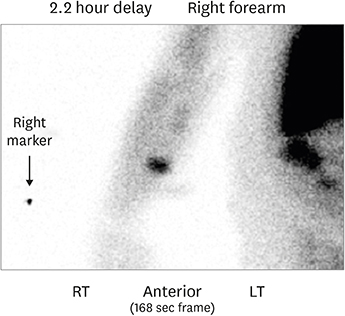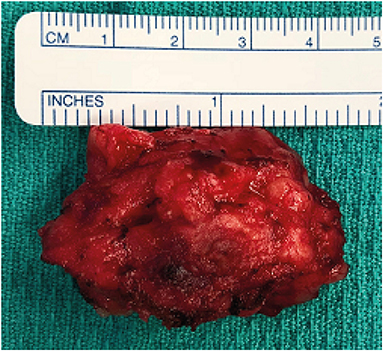J Endocr Surg.
2018 Dec;18(4):236-239. 10.16956/jes.2018.18.4.236.
Hyperplastic Autotransplanted Parathyroid Tissue Migrating into Fatty Tumor after Total Parathyroidectomy
- Affiliations
-
- 1Florida Hospital General Surgery Residency Program, Orlando, FL, USA. Joseph.Reza.MD@flhosp.org
- KMID: 2429811
- DOI: http://doi.org/10.16956/jes.2018.18.4.236
Abstract
- Secondary hyperparathyroidism (SHPTH) occurs commonly in patients with end-stage renal disease (ESRD). Uncontrolled SHPTH is associated with complications of calcium deposition including calciphylaxis and elevated rates of cardiovascular morbidity. Current treatment recommendations for medically refractory disease include total parathyroidectomy, often with autotransplantation (TPTH+AT) of minced parathyroid gland. Surgical intervention is associated with a reduction in cardiovascular mortality. We report a case of a 56-year-old man with ESRD who developed SHPTH and underwent TPTH+AT of parathyroid tissue into the right brachioradialis muscle. Over the course of 7 years he developed a mass at the site of the autotransplanted gland as well as recurrent refractory hyperparathyroidism with increased forearm uptake noted on sestamibi scan. After excision of this mass, pathology demonstrated hyperplasia of the minced gland fragments which were embedded within a mass of fibroadipose tissue rather than the muscle tissue it was originally transplanted in.
MeSH Terms
Figure
Reference
-
1. Hedgeman E, Lipworth L, Lowe K, Saran R, Do T, Fryzek J. International burden of chronic kidney disease and secondary hyperparathyroidism: a systematic review of the literature and available data. Int J Nephrol. 2015; 2015:184321.
Article2. Liu ME, Qiu NC, Zha SL, Du ZP, Wang YF, Wang Q, et al. To assess the effects of parathyroidectomy (TPTX versus TPTX+AT) for secondary hyperparathyroidism in chronic renal failure: a systematic review and meta-analysis. Int J Surg. 2017; 44:353–362.
Article3. Anderson K Jr, Ruel E, Adam MA, Thomas S, Youngwirth L, Stang MT, et al. Subtotal vs. total parathyroidectomy with autotransplantation for patients with renal hyperparathyroidism have similar outcomes. Am J Surg. 2017; 214:914–919.
Article4. Li JG, Xiao ZS, Hu XJ, Li Y, Zhang X, Zhang SZ, et al. Total parathyroidectomy with forearm auto-transplantation improves the quality of life and reduces the recurrence of secondary hyperparathyroidism in chronic kidney disease patients. Medicine (Baltimore). 2017; 96:e9050.
Article5. Tominaga Y, Matsuoka S, Uno N, Tsuzuki T, Hiramitsu T, Goto N, et al. Removal of autografted parathyroid tissue for recurrent renal hyperparathyroidism in hemodialysis patients. World J Surg. 2010; 34:1312–1317.
Article
- Full Text Links
- Actions
-
Cited
- CITED
-
- Close
- Share
- Similar articles
-
- Recurrent hyperparathyroidism due to proliferation of autotransplanted parathyroid tissue in a multiple endocrine neoplasia type 2A patient
- The Relationship between Unintentional Parathyroidectomy and Postoperative Hypocalcemia
- A Case of Hungry Bone Syndrome after Removal of a Parathyroid Adenoma
- A Case of Newly Detected Ectopic Mediastinal Parathyroid Gland in Chronic Renal Failure Patient after Parathyroidectomy
- Clinical Significances of the Unintentional Parathyroidectomy during Operation for Thyroid Carcinoma



